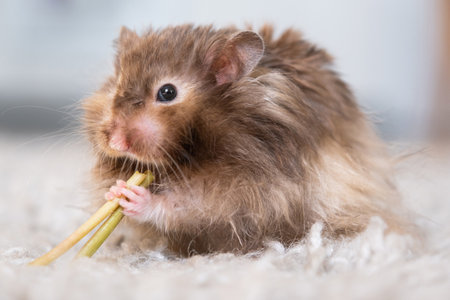Introduction: Why Food Safety Matters for Hamsters
Hamsters may be tiny, but their nutritional needs are just as important as those of any other pet. Providing your hamster with a proper diet is crucial for its overall health and well-being. Many new hamster owners assume that all fruits, vegetables, or even human snacks are safe for these little pets, but this isnt always the case. In fact, there are several common misconceptions about what hamsters can eat, which can lead to unintentional harm. Some foods that are perfectly healthy for humans or other animals can actually be toxic or dangerous for hamsters. Feeding unsafe foods can cause digestive problems, allergic reactions, or even life-threatening illnesses. Thats why understanding the difference between safe and unsafe foods is essential to keep your furry friend healthy and happy. In this guide, we’ll break down what you need to know about hamster food safety so you can make informed choices every time you fill their food bowl.
Safe Foods for Hamsters
When it comes to feeding your hamster, offering a variety of fresh and nutritious foods is key to keeping them healthy and happy. Many foods commonly found in American kitchens are safe for hamsters when served in moderation. Here’s a handy guide to the fruits, vegetables, grains, and proteins that are both easily available in the US and beneficial for your furry friend.
Fruits
Small pieces of fruit can be a tasty treat for hamsters, but avoid citrus due to its acidity. Stick to these options:
| Fruit | Serving Tip |
|---|---|
| Apple (seedless) | Thin slice, no seeds |
| Banana | Small chunk |
| Blueberries | One or two berries |
| Strawberries | Tiny piece |
Vegetables
Vegetables are a great source of vitamins and fiber. Always wash thoroughly and serve raw or lightly steamed:
| Vegetable | Serving Tip |
|---|---|
| Carrot | Tiny cube or slice |
| Cucumber | Small slice, peel optional |
| Broccoli | Tiny floret, uncooked or lightly steamed |
| Zucchini | Thin slice, raw or cooked |
Grains
Whole grains provide energy and should be offered occasionally as part of a balanced diet:
- Plain oats (uncooked)
- Cooked brown rice (cooled, unsalted)
- Whole wheat bread (very small piece, no butter)
- Puffed rice cereal (unsweetened)
Proteins
A small amount of protein can help meet your hamster’s dietary needs. Here are some safe choices:
| Protein Source | Serving Tip |
|---|---|
| Boiled egg (white only) | Pea-sized piece, no yolk or seasoning |
| Baked chicken (plain) | Tiny sliver, no skin or spices |
| Cottage cheese (low-fat, plain) | Dab on a spoon, very limited amount |
| Mealworms (dried or live) | No more than one or two at a time; best as an occasional treat |
Important Tips for Feeding Safe Foods:
- Always introduce new foods gradually to watch for allergies or digestive issues.
- Avoid giving sugary treats too often—even safe fruits should be fed sparingly.
- Remove uneaten fresh food after a few hours to prevent spoilage.
- Your hamster’s main diet should still be quality commercial hamster pellets.
Your hamster will thrive with a little variety and plenty of care—just remember that moderation is key when offering these safe foods!

3. Unsafe Foods to Avoid
While it can be tempting to share your favorite treats with your hamster, certain foods commonly found in American households are actually dangerous for these tiny pets. Some foods are toxic, while others may simply be too high in sugar, salt, or fat for a hamster’s delicate digestive system. Here’s a list of foods you should always keep away from your hamster:
Foods That Are Toxic
- Chocolate: Contains theobromine and caffeine, which are highly toxic to hamsters.
- Onions and Garlic: These can cause blood disorders and digestive upset.
- Raw Potatoes and Potato Chips: Raw potatoes contain solanine, a toxic compound; chips are also too salty and fatty.
- Citrus Fruits (like oranges, lemons, limes): The acidity can cause severe stomach upset.
- Avocado: Contains persin, which is poisonous to hamsters.
- Grapes and Raisins: Can lead to kidney failure in some small animals.
Unhealthy American Snacks to Avoid
- Sugary Cereals (such as Froot Loops or Frosted Flakes): Too much sugar can cause diabetes and obesity.
- Peanut Butter (especially salted or sweetened varieties): High in fat and additives that are unhealthy for hamsters.
- Bread and Crackers: Especially those with added sugar, salt, or seeds that can choke small pets.
- Pretzels and Potato Chips: Excess salt is harmful to hamsters’ kidneys and overall health.
Dairy Products
Avoid giving your hamster milk, cheese, or yogurt. Hamsters are lactose intolerant, and dairy can cause diarrhea or digestive discomfort.
Caution With Processed Foods
Processed foods like lunch meats, hot dogs, pizza crusts, or cookies often contain preservatives, artificial flavors, and too much fat or sugar. Always stick to fresh, healthy options designed for small animals instead of sharing table scraps or junk food with your furry friend.
4. Recognizing Signs of Food-Related Illness
Even when you’re careful about your hamster’s diet, accidents can happen. It’s important to know how to spot the warning signs if your furry friend eats something unsafe or develops a food-related illness. Quick action can make all the difference in keeping your hamster healthy and safe.
Common Symptoms of Food-Related Illness in Hamsters
| Symptom | Description |
|---|---|
| Diarrhea | Loose or watery stools, often a sign of digestive upset or poisoning. |
| Lethargy | Unusual tiredness or lack of energy; your hamster may sleep more or seem uninterested in activities. |
| Loss of Appetite | Refusing to eat, which can quickly lead to dehydration and weakness. |
| Labored Breathing | Heavy, rapid, or shallow breathing that is not normal for your pet. |
| Swelling or Bloating | A visibly distended stomach, sometimes caused by gas-producing foods or toxic substances. |
| Unusual Behavior | Any sudden changes, such as biting, hiding more than usual, or stumbling while walking. |
| Excessive Drooling or Wet Chin | This could indicate oral irritation from eating something harmful. |
| Vomiting (rare) | Hamsters rarely vomit, but attempts to retch or spit up food are serious signs. |
What To Do If You Notice These Symptoms
- Remove any remaining unsafe food: Check your hamster’s cage and clear out anything suspicious right away.
- Monitor closely: Keep an eye on your hamster’s symptoms and behavior over the next few hours.
- Offer fresh water: Make sure there is plenty of clean water available at all times.
- Avoid giving new foods: Stick with a simple diet of their regular pellets until you know they are feeling better.
- Contact a vet immediately if symptoms are severe or don’t improve:
When To Call The Vet?
- If your hamster is very weak, can’t move, is having trouble breathing, or is bleeding.
- If diarrhea lasts longer than 24 hours.
- If you see swelling, severe bloating, or any signs of pain.
- If you’re unsure what they ate or think it was a toxic substance (like chocolate, onions, garlic).
Your Responsibility as a Pet Owner
The best way to keep your hamster safe is prevention—know which foods are safe and always introduce new treats slowly. But if you ever notice any unusual symptoms after a meal, don’t wait—your quick response could save your hamster’s life. When in doubt, always reach out to a small animal vet who has experience with hamsters for professional advice.
5. Tips for Feeding Your Hamster Safely
Feeding your hamster the right way is just as important as choosing safe foods. Here are some best practices to ensure your furry friend stays happy and healthy:
Introduce New Foods Gradually
When trying a new treat or food, always introduce it slowly. Start with a tiny amount and watch for any signs of digestive upset, such as diarrhea or lack of appetite. This gradual approach helps prevent stomach issues and allows you to spot allergies or sensitivities early on.
Mind the Portion Sizes
Hamsters are small animals with even smaller stomachs. Overfeeding can lead to obesity and related health problems. A good rule of thumb is to offer a piece about the size of your hamster’s paw as a treat, no more than once a day. Their main diet should still be high-quality hamster pellets mixed with occasional fresh veggies or fruits.
Create a Balanced Diet
Your hamster’s diet should include a variety of foods to meet their nutritional needs. Alongside commercial pellets, offer safe vegetables like carrots, broccoli, and cucumber. Limit fruits due to their sugar content, and avoid feeding them every day. Always provide fresh water and remove uneaten food daily to prevent spoilage.
Tailor Meals to Your Hamster’s Breed and Age
Different breeds and ages may have unique dietary requirements. For example, dwarf hamsters are prone to diabetes and need less sugar in their diets compared to Syrians. Young hamsters might benefit from extra protein, while older ones may need softer foods.
Monitor Health Regularly
Keep an eye on your hamster’s weight, fur quality, and energy levels as indicators of good nutrition. If you notice sudden changes after introducing a new food, consult a veterinarian familiar with small pets.
By following these tips for safe feeding, you’ll help your hamster thrive while minimizing the risks associated with unsafe foods or improper diet habits.
6. Conclusion: Keeping Your Hamster Happy and Healthy
When it comes to your hamster’s well-being, what you put in their food bowl matters just as much as how much love you give them. The key takeaway is simple: stick to a balanced diet focused on high-quality hamster pellets, supplemented with safe fresh fruits, veggies, and occasional treats. Always double-check if a new food is hamster-safe before sharing your snack. Avoid foods that are toxic or hard for hamsters to digest, such as chocolate, garlic, onions, citrus fruits, and processed human foods. Remember, even healthy treats should be offered in moderation to prevent obesity and digestive issues. By making smart choices about your hamster’s diet and staying informed about what’s safe and what’s not, you’ll help your furry friend stay active, happy, and healthy for years to come.


